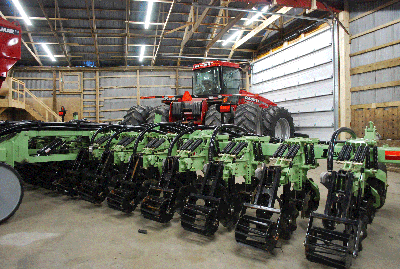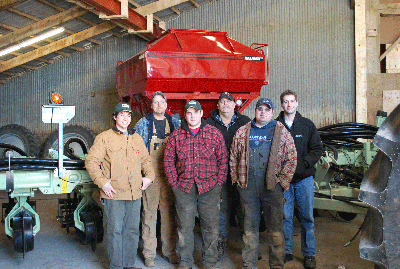Family farm embraces new technology
INVESTING IN NEW TILLAGE PRACTICES IS SET TO IMPROVE A FARM NEAR SIMCOE
with shrinking margins and continual cost pressures, the owner-operators of Schuyler Farm are always looking for new and innovative ways to maximize their land’s productivity.
“It’s been conveyed to me that large-scale farms couldn’t manage their land as well as smaller-scale farms,” says Brett Schuyler. “But today, with the technology available, a producer can manage at whatever intensity they choose, regardless of scale.”
Brett, along with his parents, brother and aunt and uncle, manages a diversified farm near Simcoe, Ontario. In addition to over 2,500 acres of corn and soybean production, the Schuylers also produce tree fruits and processing vegetables such as carrots, red beets, and cucumbers on their sandy soil. They employ 12 people full time and 100 seasonal workers.
SCHUYLER FARM’S NEWEST TILLAGE IMPLEMENT, THE ORTHMAN 1TRIPR

Recognizing the importance of land management, they are continually looking for new technologies to cut costs, increase their yields, and decrease their environmental impact. In the spring of 2009, the family looked at investing in strip till technology to meet their goals.
time for tillage
“Strip tillage is basically a practice where a narrow band is tilled specifically for creating a seed bed and the rest of the field is left untilled for conservation purposes,” explains Larry Prong, GPS Specialist at EFS Precision, a division of Elmira Farm Services.
In the Schuyler’s situation, they will till 10 inches of soil every 30 inches, leaving the soil in between undisturbed. These strips can be tilled in either the fall or spring so corn can be planted directly into these prepared seed beds.
In order to take advantage of this tillage technology, a farmer must invest in several different pieces of equipment, the first being an RTK tower and corresponding GPS units. “High accuracy guidance is a critical component of strip till,” says Prong.
An RTK tower, erected on the farm, allows for sub-inch GPS accuracy within a 10 mile radius. “The key benefit of RTK accuracy is repeatability,” explains Prong. In a strip tillage practice, the planter must be able to drive directly over the strips that have been previously tilled.
Although there are several options when it comes to tillage implements, the Schuyler’s went with the Orthman 1tRIPr pre-plant tillage tool. Adam Souder, Orthman’s Territory Development Representative explains that the 1tRIRr aims to accomplish four things: “apply fertilizer, address compaction, manage residue and prepare a good seed bed.”
According to Souder, the implement has rock protection built in and allows precision depth control for banding fertilizer with independently carried row units.
managing more trash
One cropping practice strip till can help improve is corn on corn rotations. Although planting corn after corn is still not widely established in the province, there are a handful of farmers that are doing so without yield losses.
When combined with higher yielding corn, which has a tendency to produce more organic matter, planting corn on corn can create a trash management challenge. “This combination means that it requires a lot of tillage to prepare the seed bed for planting,” explains Schuyler.

SCHUYLER FARM EMPLOYEES IN FRONT OF THEIR NEW EQUIPMENT. FROM LEFT TO RIGHT: BREET SCHUYLER, RICK BARBER, CHUCK TULPIN, DREW SCHUYLER, JOHN BURBRIDGE, RYAN SCHUYLER
“Before, under extreme circumstances, we were doing two passes with a disc and one pass with a cultivator to prepare the soil for planting corn in the spring,” says Schuyler. “Because we have such sandy soil, we did most of this cultivating in the spring to avoid erosion and it was a real bottleneck in our operations,” he continues.
This spring, the Schuylers plan on eliminating this bottleneck with their new strip till technology. “We’re also looking forward to reduced variable costs, such as fuel, as we combine three operations into one,” says Schuyler.
With the new strip till implement the Schuylers will be able to prepare a good seed bed with one pass. Before, three field operations, two passes with the disc and one pass with the cultivar, were required to prepare for corn planting.
maximizing moisture and minimizing erosion
In addition to the obvious benefits of strip tillage that reduces three field operations into one, there are also a lot of environmental benefits.
“Farming on such sandy soil means that you are always trying to find ways to reduce the risk of erosion,” explains Schuyler. “By exposing a 10 inch strip of soil, instead of the entire field, there is much less concern about wind and water erosion.”
Souder echoes this sentiment and sites the many benefits of leaving a large portion of the field untilled. “Leaving corn stalks standing in the field 15 inches to the side of the new crop allows for good wind protection for young seedlings and helps maintain organic matter in the soil,” he explains.
When trying to maintain and promote healthy topsoil, erosion is not the only concern. A strip tillage system will also help reduce compaction, as it requires less passes over the field, and assist with water conservation by preserving the organic matter on top of the soil surface for the 20 inches between the planted rows.
challenges
Although Schuyler is looking forward to trying the new system out this spring, he is aware that there may be challenges to face.
“The biggest challenge is hitting the strip when you’re planting,” he says. “There is no point to the system if you can’t get the seed right in that 10 inch strip of tilled earth.”
Overcoming the challenge of functional technology is the main reason the Schuyler farm invested in the RTK tower the year before they purchased the strip till implement.
“We put up an RTK tower on the farm last spring and used it with our existing field operations all throughout the 2009 crop season,” explains Schuyler. “We wanted to be sure that we were comfortable with the GPS technology before we invested in the strip till implement,” he continues.
Schuyler is also eager to find out what, if any, changes this new system will require of their weed and disease management. “We don’t anticipate the new tillage system causing any unmanageable problems,” he says. “But, there is always a bit of unknown when it comes to weeds and disease, or anything in farming. You can’t know how that’s going to play out every year.” •







